Reducing Workforce Planning Costs with AI-Powered Talent Intelligence
Key Takeaways:
- AI-powered talent intelligence platforms offer unprecedented insights into role and location-specific talent costs, enabling more strategic workforce planning.
- These platforms can reduce talent acquisition costs by providing accurate cost modeling, competitor analysis, and optimized recruitment strategies.
- Hidden costs in workforce planning, such as onboarding, training, and productivity ramp-up, can be significantly reduced through more precise talent matching.
- AI-driven insights allow companies to make data-informed decisions about team structure, location, and skill distribution, leading to more cost-effective workforce strategies.
- The use of AI in talent acquisition is shifting the focus from mere cost-saving to value creation, with 77% of talent leaders now prioritizing total value creation for their companies.
Rising talent acquisition costs are a major concern for organizations in today’s evolving job market. With the average cost per hire at $4,700, and total costs potentially reaching three to four times a position’s salary, companies are seeking innovative solutions.
A paradigm shift is occurring:
- 77% of talent leaders now prioritize total value creation over cost savings
- 60% of organizations have increased investment in emerging recruitment technologies
This shift emphasizes the need for granular insights at both role and location levels. Understanding talent pools, salary expectations, and skill availability across different areas is crucial for building a cost-effective workforce.
AI-powered talent intelligence platforms are emerging as a solution, offering actionable insights by analyzing vast amounts of data. These platforms provide crucial information for strategic workforce planning, potentially leading to significant cost savings and more effective talent acquisition strategies.
For instance, while a senior software developer might command a salary of $150,000 in Silicon Valley, an equally skilled professional in an emerging tech hub like Austin or Raleigh might be available for $120,000. Similarly, certain roles might be more cost-effective to fill remotely, tapping into global talent pools without the overhead of relocation costs.
Role-specific insights can reveal unseen opportunities for strategic workforce planning. For example, data might show that for a particular technical role, hiring a mix of senior and junior professionals and investing in upskilling could be more cost-effective in the long run than solely pursuing experienced hires.
AI-powered talent intelligence platforms analyze vast amounts of data to provide actionable intelligence on:
- Salary benchmarks for specific roles across different locations
- Talent pool depth and quality in various geographical areas
- Skill availability and emerging talent hubs for specific roles
- Cost of living adjustments and their impact on total compensation
- Remote work suitability for different roles and its impact on costs

Armed with these insights, companies can make strategic decisions about where to locate teams, how to structure roles, and where to focus their recruitment efforts. This data-driven approach not only helps in building a more cost-effective workforce but also ensures that organizations are positioned to attract and retain the talent they need to drive innovation and success.
In the following sections, we’ll explore how AI-powered talent intelligence platforms provide these crucial role and location level insights, and how organizations can leverage this information to build agile, cost-effective workforces that drive value in an increasingly competitive global market.
The Challenges of Workforce Planning – Complexities in Role and Location-Based Planning
Workforce planning becomes even more complex when factoring in the nuances of specific roles and geographical locations.
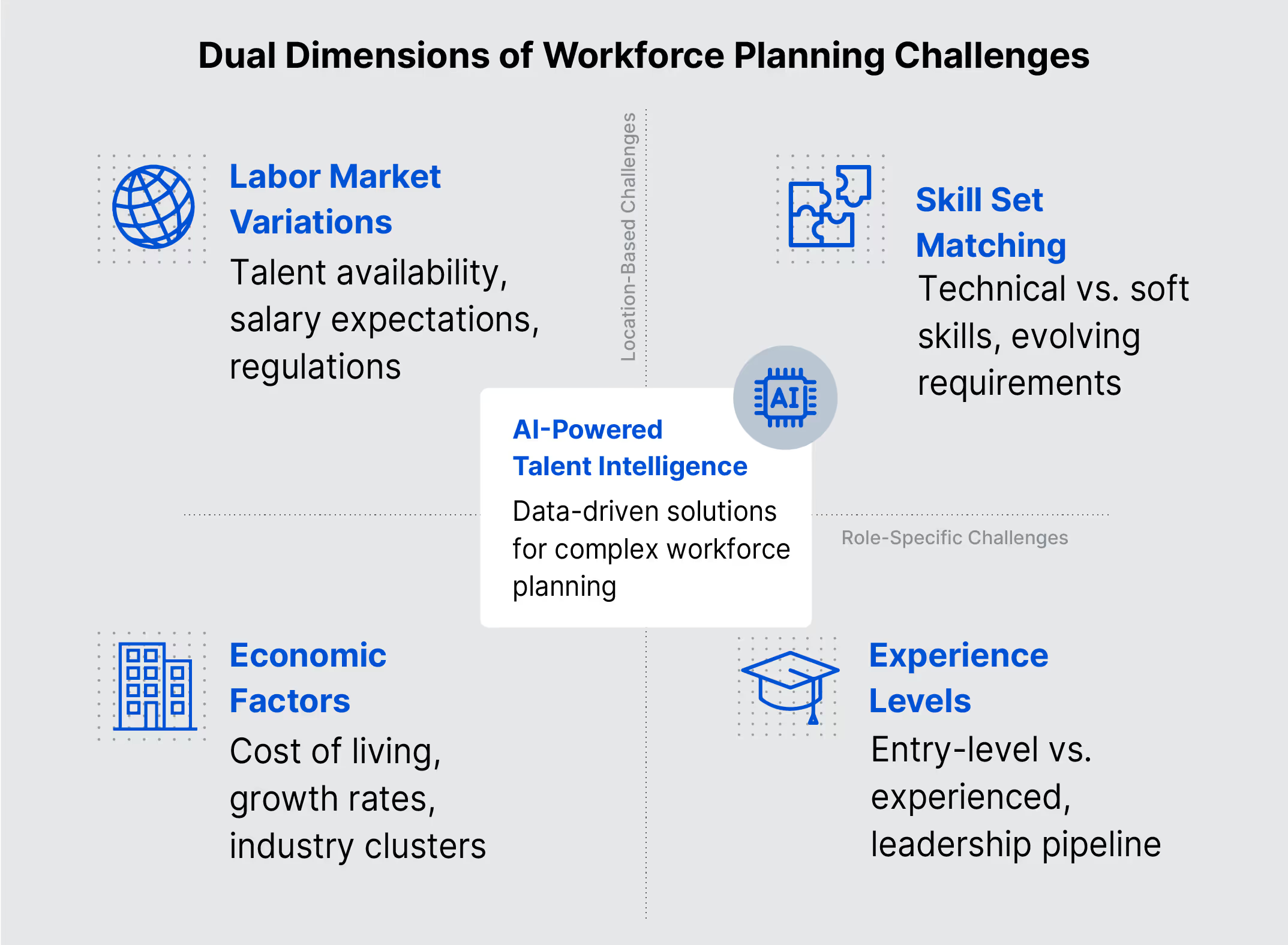
Understanding regional variations and specific role requirements presents several challenges:
1. Location-wise Variations:
a) Labor Market Conditions:
- Talent Availability: Some regions may have a surplus of certain skills while others face shortages. For example, tech hubs like Silicon Valley have a higher concentration of software developers compared to rural areas.
- Salary Expectations: Compensation expectations can vary significantly between locations. For instance, salaries in major cities are typically higher than in smaller towns due to cost of living differences.
- Employment Regulations: Labor laws and regulations can differ greatly between countries and even states/provinces within a country. This impacts hiring practices, employee benefits, and termination procedures.
b) Economic Factors:
- Cost of Living: This affects salary requirements and can influence employee relocation decisions. High cost-of-living areas may require higher compensation packages to attract talent.
- Economic Growth Rates: Regions experiencing rapid economic growth may offer more opportunities but also face increased competition for talent.
- Industry Clusters: Some areas have concentrations of specific industries, affecting the availability of specialized talent and the competitiveness of the job market.
c) University Intelligence:
- Graduation Rates and Talent Pools: Analyze data from universities to identify regions with high graduation rates in specific fields, providing insights into emerging talent pools.
- University-Industry Partnerships: Track partnerships between universities and industries, indicating potential sources of talent with industry-specific training and experience.
2. Role-Specific Requirements:
a) Skill Sets:
- Technical vs. Soft Skills: Different roles require varying balances of technical and soft skills. For example, a software developer needs strong coding skills, while a sales manager requires excellent interpersonal skills.
- Evolving Skill Requirements: Rapid technological changes mean that skill requirements for many roles are constantly evolving, making it challenging to find up-to-date talent.
- Interdisciplinary Skills: Many modern roles require a combination of skills from different disciplines, complicating the search for suitable candidates.
b) Experience Levels:
- Entry-Level vs. Experienced Hires: Organizations need to balance hiring fresh graduates who can be molded to company culture with experienced professionals who can hit the ground running.
- Leadership Pipeline: Planning for future leadership roles requires identifying and developing high-potential employees early in their careers.
- Industry-Specific Experience: Some roles may require deep industry knowledge, limiting the pool of suitable candidates.
c) Regulatory Compliance:
- Professional Certifications: Certain roles, especially in fields like finance, healthcare, and law, require specific certifications or licenses.
- Industry Standards: Some industries have strict standards and regulations that employees must adhere to, necessitating specialized training and compliance measures.
- Data Privacy and Security: With increasing focus on data protection, roles handling sensitive information may require additional security clearances or training.
3. Additional Considerations:
a) Remote Work Trends:
- The rise of remote work has added another layer of complexity to location-based planning, as it expands the potential talent pool but also introduces challenges in team cohesion and management.
b) Diversity and Inclusion:
- Organizations need to consider how their workforce planning strategies impact diversity and inclusion goals across different locations and roles.
c) Succession Planning:
- Identifying and preparing successors for key roles becomes more complex when considering geographical and role-specific factors.
d) Technology Adoption:
- The rate of technology adoption can vary by location and role, affecting the skills required and the methods used for workforce planning.
To address these multifaceted challenges, organizations are increasingly turning to advanced analytics and AI-powered talent intelligence solutions. These tools can help:
- Analyze vast amounts of data to identify trends in labor markets across different locations.
- Predict future skill requirements based on industry trends and technological advancements.
- Optimize workforce allocation by matching employee skills with role requirements across different locations.
- Provide insights into competitive compensation packages tailored to specific roles and locations.
- Identify potential skill gaps and suggest targeted training or recruitment strategies.
Addressing these challenges requires a shift from traditional methods to more advanced, data-driven approaches. AI-powered talent intelligence platforms offers the potential to overcome these limitations, providing organizations with the tools and insights needed to optimize their workforce planning processes.
AI-Powered Talent Intelligence: Enabling Cost-Efficient Workforce Planning
AI-powered Talent Intelligence offers organizations a revolutionary approach to understanding and optimizing their workforce planning strategies. By leveraging advanced talent analytics and machine learning techniques, these platforms provide deep insights into labor market trends, competitor strategies, and the true cost of talent acquisition. This technology not only streamlines the hiring process but also significantly reduces talent acquisition and workforce planning costs by enabling data-driven decision-making.
Leveraging AI for Accurate Workforce Cost Analysis at Scale
AI-powered talent intelligence platforms provide sophisticated cost modeling features that enable organizations to accurately estimate the costs of hiring talent in specific locations with required capabilities. These features help in understanding the financial implications of setting up or expanding teams in various locations by considering factors such as the experience level of the talent pool and the number of required hires.
Detailed Cost Analysis
The cost modeling capabilities of these platforms offer a detailed analysis of the total base pay for hiring multiple roles in a specific location. This allows HR professionals to accurately estimate the total cost of hiring talent, aiding in the development of effective hiring strategies.
Key Benefits
1. Accurate Cost Analysis:
- Provides a comprehensive understanding of cost metrics including:
- Salary benchmarks
- Onboarding expenses
- Training costs
- Deployment costs
- Analyzes costs based on:
- Location
- Required Skillsets
- Candidate background
- Experience levels
2. Location Analysis:
- Analyzes locations based on cost parameters.
- Helps in micro-targeting locations for recruitment purposes.
3. Competitor Analysis:
- Estimates the costs competitors incur for hiring various job roles.
- Provides insights into competitive salary benchmarks.
4. Cost-Per-Hire Tracking:
- Tracks the cost-per-hire.
- Optimizes recruitment strategies for cost-efficiency.
Leveraging these AI-powered tools allows organizations to make informed decisions about their workforce planning, ensuring that hiring strategies are both cost-effective and strategically aligned with organizational goals
Cost modelling powered by talent intelligence platforms enables users to understand the total cost estimate for hiring professionals in specific locations, providing detailed analysis, comparisons, and possibilities. Users can input various parameters such as job roles, desired locations, and the number of hires, and the platform will generate comprehensive cost projections. These projections take into account factors like base salary, benefits, taxes, and even location-specific costs like office space or remote work stipends.
Key Workforce Planning Capabilities of AI-Powered Talent Intelligence Platforms
- Workload and Skills-Level Analysis: These platforms can assess the optimal distribution of workload and required skill levels for specific roles. For instance, it might reveal that a software development team in a particular region could be more cost-effectively structured with a mix of 60% senior developers, 30% mid-level, and 10% junior developers, rather than the current 80% senior structure.
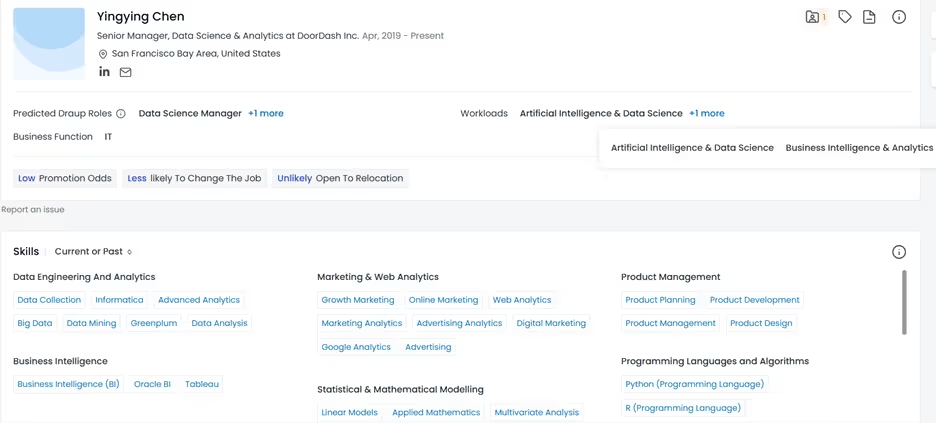
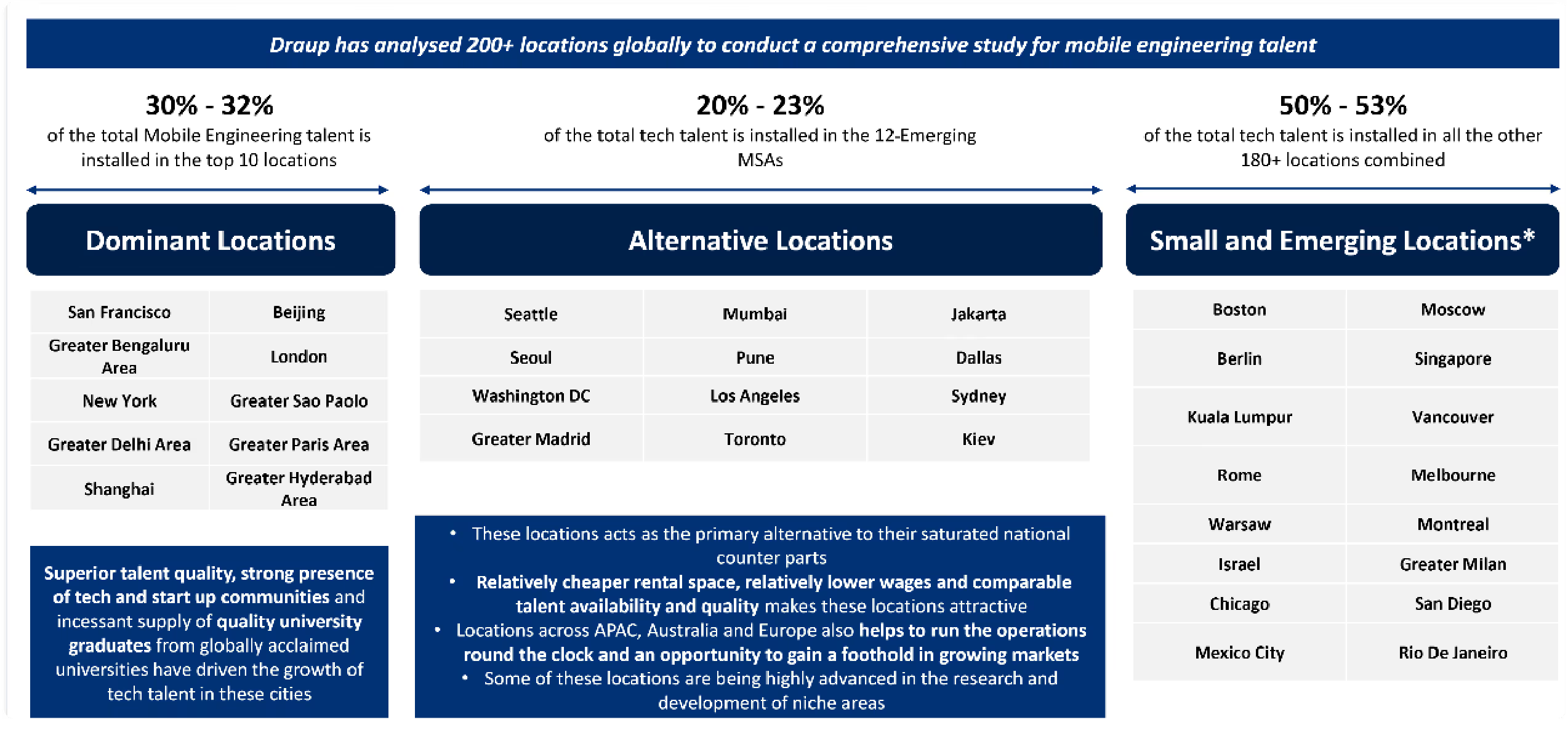
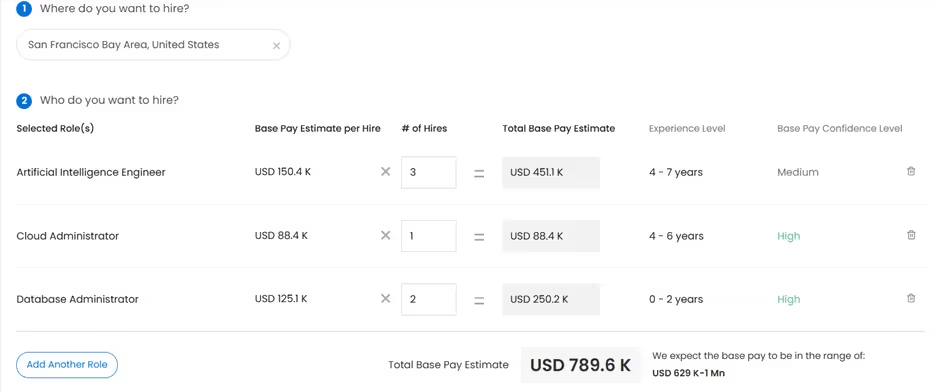
3. Team Building Cost Estimation: The platform can provide detailed estimates on the cost and timeline for building a team in a specific region. For instance, it might calculate that assembling a team of 10 full-stack developers in Boston would cost approximately $1.5 million annually and take 3-4 months, considering current market conditions and competition.
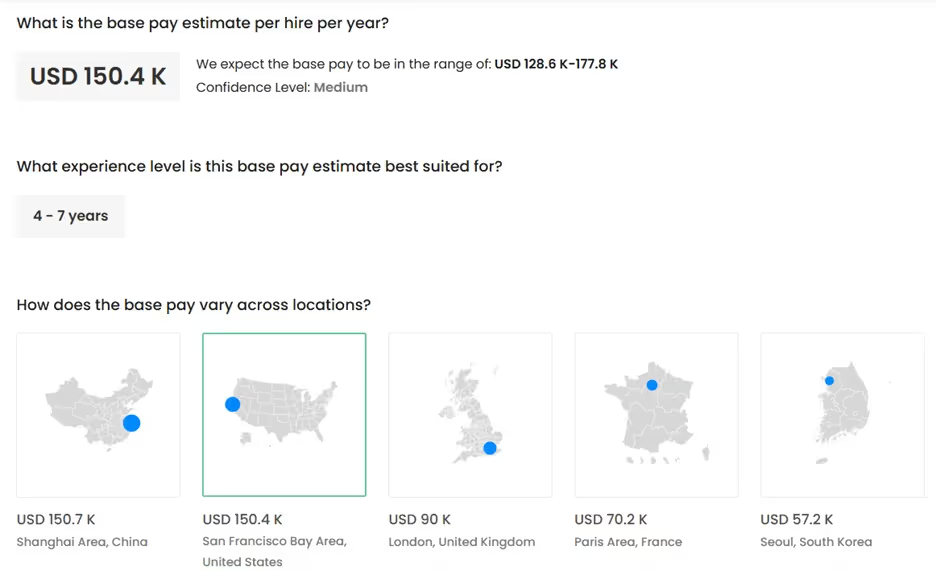
4. Role and Location Analysis: Users can view the national median cost for a role, compare it with local median costs in different locations, and gauge role demand accordingly. This feature is particularly powerful when combined with talent supply data, providing context for salary differences and hiring difficulties
5. Multi-role Cost Insights: The platform allows users to analyze the cost of hiring several roles simultaneously at selected location levels based on required capabilities. This feature is invaluable for organizations planning large-scale hiring initiatives or considering opening new offices in different locations.
Practical Application: A Case Study
Let’s consider a specific example to illustrate these capabilities:
Suppose a growing fintech company wants to expand its data science team in Austin, Texas. The AI-powered Talent Intelligence platform would:
- Review current job postings for data scientists in Austin, revealing an average of 95 open positions with a median salary of $147,000.

- Examine the expansion plans of other fintech and tech companies in the area, showing three major competitors also planning to hire data scientists in the next six months.
- Assess the skills distribution among data scientists in Austin based on self-reported data, indicating a shortage of professionals with expertise in natural language processing (NLP).
- Estimate that building a team of 5 data scientists with NLP skills in Austin would cost approximately $735,000 annually in salaries.
- Predict that the recruitment process would take 4-5 months to complete.
- Suggest offering salaries 10% above the median to compete effectively, totaling around $161,700 per data scientist.
- Provide comparative data for other tech hubs. For instance, it might show that Chicago has a talent pool of 10,000 data scientists with 138 new job postings per month, a median salary of $140,000, and a 1% talent growth rate, potentially making it a more cost-effective location for hiring.

Leveraging this information, the company can make informed decisions about their hiring strategy, potentially considering options like offering competitive salaries and benefits to attract top talent quickly, exploring nearby cities with a lower cost of living but strong data science talent pools, or investing in training existing team members in NLP skills to reduce external hiring needs.
By providing these detailed insights, AI-powered Talent Intelligence platforms enable organizations to significantly reduce talent acquisition costs for their workforce through more accurate budgeting and resource allocation, reduced time-to-hire, improved offer acceptance rates, decreased reliance on expensive external recruiters, and enhanced long-term workforce planning.
As these platforms continue to evolve, they are transforming workforce planning from a static, often costly endeavor into a strategic, proactive, data-driven practice.
Understanding the Hidden Cost Aspects of Workforce Planning
When organizations consider the expense of hiring and maintaining their workforce, they often focus primarily on salaries. However, the true cost of talent extends far beyond this basic figure. To make informed decisions about recruitment, retention, and overall workforce strategy, it’s crucial to understand the full spectrum of expenses associated with human capital.
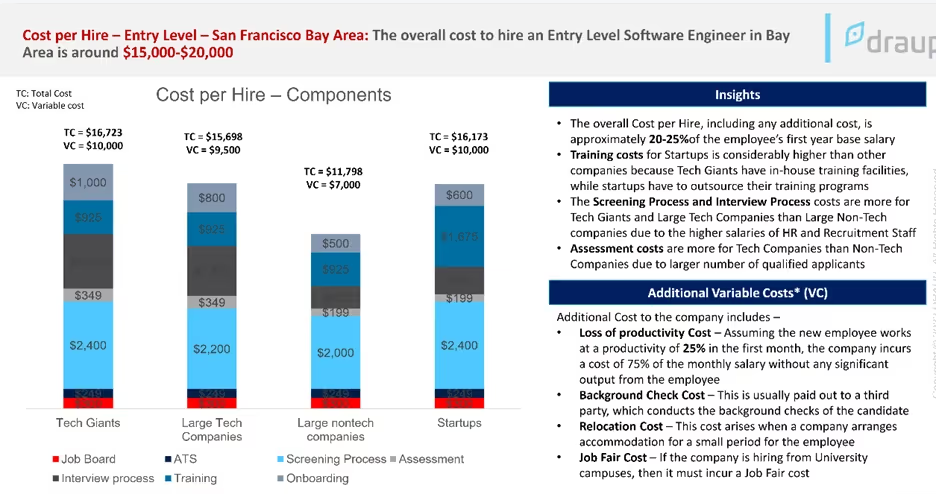
Beyond Salary
The hidden costs of talent acquisition and retention are numerous and can significantly impact a company’s bottom line. Let’s break down these often-overlooked expenses:
Sourcing & Recruitment: Before an employee even joins the company, substantial resources are invested in finding the right candidate. This includes expenses for job postings on various platforms, which can range from free listings to premium placements costing hundreds of dollars. Many organizations also work with recruitment agencies, typically charging 15-25% of the new hire’s first-year salary. Additionally, internal recruiters dedicate considerable time to each position, often spending 30-40 hours per hire on tasks such as crafting job descriptions, reviewing applications, and coordinating interviews.
AI-powered talent intelligence platforms can surface highly-relevant resumes that are aligned to the actual workload and skills that a company is looking for. This precision in candidate matching significantly reduces the time spent on initial screening, which in turn accelerates the entire hiring process. The downstream benefits are substantial, including faster offer acceptances and reduced time-to-hire, ultimately leading to cost savings in the recruitment process.
Onboarding & Training: Once a candidate is selected, the investment continues. Administrative costs for paperwork and system setup typically range from $100-$300. Formal onboarding programs, crucial for integrating new hires into the company culture and workflows, can cost the equivalent of 1-2 weeks of salary and lost productivity. Depending on the industry and role, specialized training may be necessary, potentially costing $1,000-$5,000 per employee.
While no amount of technology can offset some of these costs – onboarding, paperwork etc – AI-powered talent intelligence can help with the training aspect. Specifically, candidates shortlisted based on AI-enriched profiles as is available on talent intelligence platforms, require much less time for on-job training to get up to speed since they are guaranteed to have a high degree of skills and/or workload overlap from their previous engagements. Not to mention the insights talent intelligence platforms provide on compensation best practices and benefit packages in vogue. This level of intelligence helps talent acquisition tailor their candidate search and approach in a manner that significantly increases their chances of acceptance.
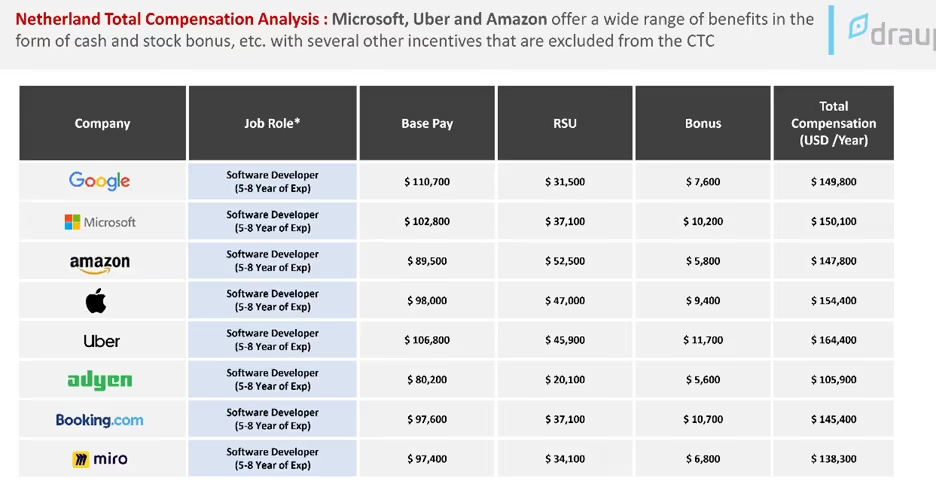
Productivity Ramp-Up: New employees rarely hit the ground running at full capacity. The time to reach full productivity can vary widely, typically ranging from 8 to 26 weeks. During this period, new hires may only be 25-50% as productive as their established colleagues, representing a significant hidden cost in terms of reduced output and additional support required from team members.
The precise skills and workload-level match facilitated by AI-powered talent intelligence platforms typically results in a shorter time to full productivity for new hires. By ensuring a closer alignment between the candidate’s capabilities and the role’s requirements, these platforms help reduce the ramp-up period. New employees can often hit the ground running, requiring less hand-holding and additional support from their colleagues. This not only minimizes the hidden costs associated with reduced productivity during the initial weeks but also allows the new hire to contribute meaningfully to the team’s output much sooner
Attrition: When employees leave, the financial impact ripples through the organization. The cost of turnover is estimated at 50-200% of an employee’s annual salary. This encompasses lost productivity, the need for knowledge transfer, and the expense of repeating the entire hiring process. High turnover rates can create a costly cycle that drags down overall organizational performance.
Conclusion:
The integration of AI-powered talent intelligence into workforce planning represents a paradigm shift in how organizations approach talent acquisition and management. By providing deep, data-driven insights into the complexities of the global labor market, these advanced platforms enable companies to move beyond traditional, often costly recruitment methods. They offer a strategic approach to understanding and optimizing the true cost of talent across various roles and locations.
As we’ve seen, the benefits of this technology extend far beyond simple cost reduction. AI-powered talent intelligence empowers organizations to make informed decisions about team structure, location strategy, and skill distribution, leading to more agile and effective workforces. It allows companies to navigate the hidden costs of recruitment, from onboarding and training to productivity ramp-up, with greater precision and foresight.
Moreover, this shift towards AI-driven talent strategies is aligning recruitment more closely with overall business objectives. By focusing on total value creation rather than mere cost-cutting, organizations can build workforces that are not only cost-effective but also strategically positioned to drive innovation and success.
As the global talent landscape continues to evolve, AI-powered talent intelligence will play an increasingly crucial role in helping organizations stay competitive. Those who embrace these tools and integrate them into their workforce planning processes will be better equipped to attract, retain, and optimize talent in a cost-effective manner. They will be able to build agile, skilled teams that can adapt to changing market conditions and drive business growth.
The future of workforce planning lies in harnessing the power of AI to create data-driven, strategic approaches to talent acquisition and management. As these technologies continue to advance, they promise to reshape the way organizations think about and invest in their most valuable asset – their people.










.svg)


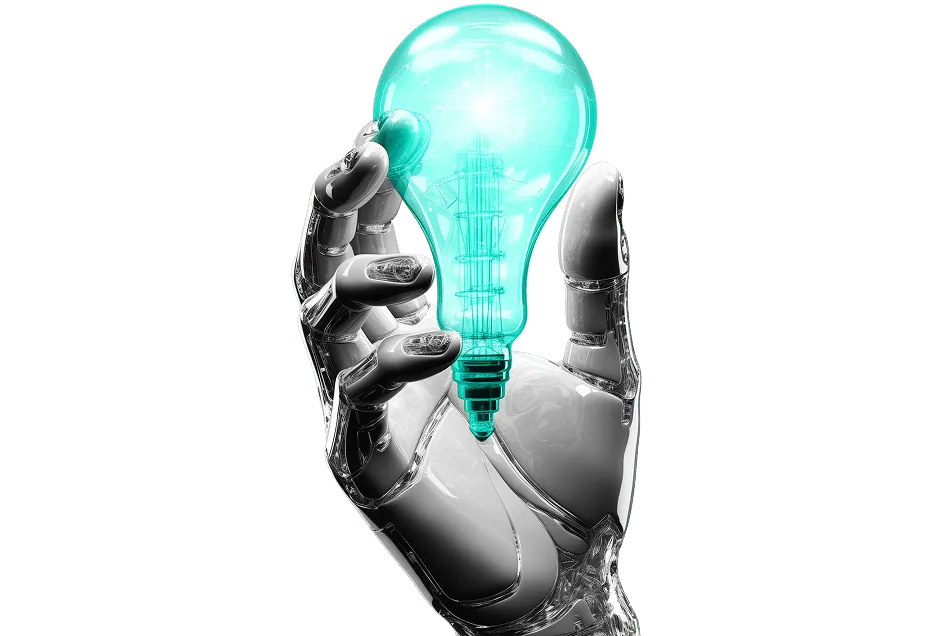
















.svg)





.svg)
